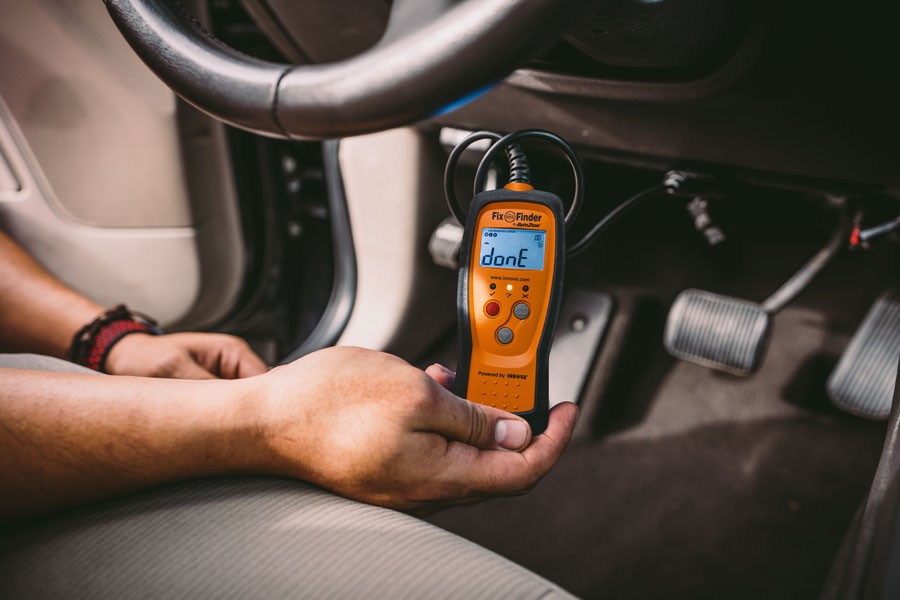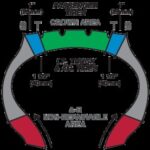A diagnostic scanner, often called an OBD2 scanner or car code reader, is an invaluable tool for modern car owners. It allows you to communicate with your vehicle’s computer system, diagnose problems, and potentially save significant money on auto repairs. Understanding how to use a diagnostic scanner is simpler than you might think. This guide will walk you through the process, from connecting the scanner to interpreting the results, so you can confidently take the first step in understanding your car’s health.
Locating the OBD-II Port: Where to Plug In
The first step is to find the OBD-II (On-Board Diagnostics II) port in your vehicle. For almost all cars and light trucks manufactured since 1996, this port is standardized for easy access. You’ll typically find it located inside the cabin, beneath the dashboard on the driver’s side.
Look for a 16-pin connector that is trapezoidal in shape. It’s often in plain sight, but sometimes it may be tucked slightly under the dash. In some less common instances, the OBD-II port could be found in the center console or even on the passenger side under the dashboard. If you’re having trouble locating it, consult your vehicle’s owner’s manual for specific guidance.
Step-by-Step Guide: Connecting Your OBD2 Scanner
Connecting the OBD2 scanner is a straightforward process that requires no special tools. The plug is designed to fit only one way, ensuring a correct connection.
Preparation Before Connecting
Before you begin, make sure your vehicle’s ignition is turned off. This is a standard precaution to ensure safe and proper communication between the scanner and your car’s computer.
Connecting the Scanner
Take your OBD2 scanner and locate the male connector on its cable. Align the trapezoidal shape of the scanner’s plug with the OBD-II port in your car. Gently but firmly push the two connectors together. You might feel a slight resistance as they connect, and a little wiggle can help ensure they are fully seated.
Powering Up and Initial Setup
Once connected, you need to provide power to the scanner. For most OBD2 scanners, the power is drawn directly from the OBD-II port itself.
Follow these steps in order:
- Ensure Ignition is OFF: Verify that your car’s ignition is completely off.
- Connect the Scan Tool: Plug the OBD2 scanner into the diagnostic port as described above.
- Turn Ignition ON (Engine OFF): Turn the ignition key to the “ON” position. This position activates the car’s electrical systems without starting the engine.
At this point, your OBD2 scanner should power up and begin its boot sequence. Wait for it to fully initialize. The scanner’s screen will then typically guide you through any additional information it requires. This might include inputting your vehicle’s engine size, VIN (Vehicle Identification Number), or instructions on whether to start the engine or not for certain tests.
Navigating the Diagnostic Scanner Menu: Key Features
After your OBD2 scanner has booted up, you’ll be presented with a menu. The options available will vary depending on the type of scanner you have. Basic code readers will have fewer features compared to advanced professional-grade scanners. However, common options you’ll likely encounter include:
Reading Diagnostic Trouble Codes (DTCs)
Selecting “Read Codes” is the primary function for most users. This option instructs the scanner to retrieve and display any Diagnostic Trouble Codes (DTCs) stored in your vehicle’s computer system. A DTC is a code assigned to a specific fault detected by the car’s sensors and systems.
The scanner will display the DTC as a code number, such as “P0301,” and may also provide a brief text description of the problem. If multiple codes are present, the scanner will usually scroll through each of them.
Erasing Codes
The “Erase Codes” or “Clear Codes” option allows you to clear stored DTCs from your vehicle’s computer memory. Typically, the scanner will ask for confirmation before erasing codes to prevent accidental deletion.
Caution: Erasing codes without addressing the underlying issue will only temporarily turn off the check engine light or warning. If the problem persists, the code and the light will likely return. It’s recommended to understand and fix the problem before clearing codes.
Live Data Monitoring
For scanners equipped with “Live Data” or “Data Stream” functionality, you can monitor real-time sensor readings from various systems in your car. This feature is incredibly useful for diagnosing intermittent issues or observing how different components are behaving while the engine is running. You can scroll through lists of parameters like engine temperature, RPM, oxygen sensor readings, and more, allowing you to see if values are within normal ranges or if sensors are responding correctly.
Freeze Frame Data
“Freeze Frame” is a valuable snapshot of data captured by the vehicle’s computer at the exact moment a DTC was set. When a fault is detected and a DTC is stored, the computer also records the values of various parameters at that instant. This “freeze frame” of data can provide crucial context and clues about the conditions under which the fault occurred, aiding in diagnosis.
Vehicle Information and I/M Readiness
The “Vehicle Info” section typically displays basic information about your car’s build, which can be helpful for identification purposes. “I/M Readiness,” short for Inspection and Maintenance Readiness, is specifically related to emissions testing. This function checks the status of various emissions-related systems and indicates whether your vehicle is ready for a smog check. It can highlight potential issues that might cause you to fail an emissions test.
Navigating the scanner’s menu is usually done using buttons on the device. Arrow buttons allow you to scroll through menu options, a select or “OK” button confirms your choice, and a “back” or “escape” button helps you navigate to previous menus. Even Bluetooth or Wi-Fi OBD2 scanners controlled via smartphone apps will have similar menu structures and functionalities.
 OBD-II scanner done reading trouble codes
OBD-II scanner done reading trouble codes
Image alt text: A handheld OBD2 scanner displaying diagnostic trouble codes on its screen after a successful vehicle scan.
Understanding Diagnostic Trouble Codes: Decoding the Meaning
When you use the “Read Codes” function, the scanner will display a DTC. These codes are standardized across the automotive industry to help technicians and DIYers understand the nature of the problem. DTCs follow a specific format: a letter followed by four numbers (e.g., P0301).
The first letter indicates the system where the fault originated:
- P (Powertrain): Relates to the engine, transmission, fuel system, and emissions control systems.
- B (Body): Concerns body control systems, including airbags, power windows, interior electronics, etc.
- C (Chassis): Deals with chassis systems like ABS (Anti-lock Braking System), suspension, and steering.
- U (Network/Communication): Indicates communication issues between different electronic control units (ECUs) in the vehicle.
The first number after the letter is either a ‘0’ or a ‘1’:
- 0: Indicates a generic code. These codes are standardized by the Society of Automotive Engineers (SAE) and are common across all vehicle manufacturers.
- 1: Signifies a manufacturer-specific code. These codes are defined by the specific car manufacturer and may have a more detailed or nuanced meaning than generic codes.
The second digit in the numeric part of the code further specifies the subsystem within the broader system indicated by the letter. For Powertrain (P) codes, the second digit categories are:
- 1: Fuel and Air Metering
- 2: Fuel and Air Metering (Injector Circuit)
- 3: Ignition System or Misfire
- 4: Auxiliary Emission Controls
- 5: Vehicle Speed Control & Idle Control
- 7, 8, 9: Transmission Related
- A, B, C: Hybrid Propulsion System
The third and fourth numbers provide even more specific information about the fault within the identified system and subsystem. There are hundreds of possible combinations, each with a specific description.
Example: Decoding P0301
Let’s break down the example code P0301:
- P: Powertrain (engine or transmission related)
- 0: Generic code (common across manufacturers)
- 3: Ignition System or Misfire
- 01: Specifically points to Cylinder #1
Therefore, P0301 indicates a generic powertrain code related to the ignition system or a misfire, specifically in Cylinder #1. In plain terms, it means there is a misfire detected in cylinder number one of the engine.
Benefits of Using a Diagnostic Scanner: Saving Time and Money
Investing in and learning how to use a diagnostic scanner can lead to significant savings and a better understanding of your vehicle.
Firstly, when your “Check Engine” light illuminates or you experience a performance issue, a quick scan can provide an initial indication of the problem’s source. While it may not pinpoint the exact cause, it gives you a starting point for diagnosis.
Secondly, as mentioned earlier, the I/M Readiness test can help you determine if your car is likely to pass an emissions test, preventing unexpected failures and re-test fees.
Most importantly, by identifying the DTC and researching its meaning, you can often diagnose and even repair simple issues yourself, avoiding costly trips to a mechanic for basic diagnostics. For example, a code like P0138, indicating a high voltage reading from the bank 1 sensor 2 oxygen sensor, often points to a faulty oxygen sensor. With this information, you can choose to replace the sensor yourself, clear the code using your scanner, and potentially resolve the issue without professional help.
OBD2 scanners empower car owners to be more proactive in vehicle maintenance and repair, saving both time and money. Consider purchasing an OBD2 scanner to expand your DIY car care capabilities. Many auto parts stores, like AutoZone, offer a range of scanners, and some even have loan-a-tool programs where you can borrow a scanner for free.
FAQ/People Also Ask
How do you use OBD II scanner?
Plug the scanner into the OBD-II port under your dashboard, turn the ignition to the “ON” position (engine off), and follow the on-screen instructions to read codes, view live data, or perform other diagnostic functions.
Does car have to be running to use OBD2 scanner?
No, in most cases, you can read trouble codes and access basic functions with the ignition in the “ON” position (engine off). Live data monitoring and some advanced tests may require the engine to be running.
How do I read my OBD scanner?
Navigate the scanner’s menu to find the “Read Codes” option. Select it to display any active and pending diagnostic trouble codes (DTCs). Note down the codes and use resources online or in your scanner’s manual to understand their meaning.
Can you plug in OBD scanner while car is running?
While technically possible, it’s generally not recommended to plug in or unplug an OBD2 scanner while the engine is running. It’s best practice to connect or disconnect the scanner with the ignition off to avoid any potential electrical interference or communication issues. If you need to initiate a test with the scanner, follow the manufacturer’s instructions, which may involve turning the ignition off and then back on.

